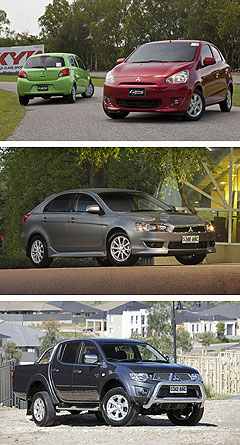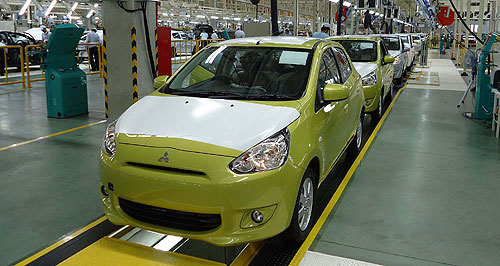Make / Model Search
News - MitsubishiMitsubishi’s increasing reliance on Thai importsThai die: The metal stamping facility on the Mirage production line at Mitsubishi’s Laem Chabang factory in Thailand has six robots and 32 staff, currently operating on one shift. Thai-built cars expected to account for up to 40 per cent of local Mitsubishi sales28 May 2012 MITSUBISHI’S factory in Laem Chabang, Thailand, is expected to supply up to 40 per cent of the brand’s cars sold in Australia if the new Mirage light car meets its sales expectations following its January 2013 launch, but the company has no plans to increase the number of Thai-sourced models beyond that for now. Mitsubishi Australia vice-president for customer and brand management Paul Unerkov told GoAuto the Triton one-tonne ute, Challenger SUV and upcoming Mirage are important to both the company and its dealer network as they help drive profitability through accessories and financing – in addition to the obvious volume throughput. “Over the last couple of years we have maintained our market share and kept it pretty static,” he said. “We have always said we have an opportunity to grow our market share with new Mirage because it is a segment of about 15 per cent of the market and a segment we don’t really compete in, so for us it is a pure incremental volume opportunity to grow the business.” Although there are production cost advantages and a free trade agreement to leverage from sourcing cars out of Thailand, Mr Unerkov said he would be “very surprised” if more models started coming from Laem Chabang in the near future. Mitsubishi built 220,000 vehicles in Thailand during its 2011 financial year, which is expected to rise 74 per cent to 382,000 in FY2012 – mainly due to the arrival of the Mirage, which is built on a new production line that began operating only last month.  From top: Mitsubishi Mirage, Lancer and Triton. From top: Mitsubishi Mirage, Lancer and Triton.This recently completed third line at Laem Chabang means it now has a total capacity of 460,000 units per year, split between Triton, Challenger, current-generation Lancer, previous-generation Lancer and now Mirage. In response to initial demand in Thailand for the Mirage far exceeding the anticipated monthly volume of between 2000 and 2500 units, Mitsubishi is running the line on Saturdays, even though the facility is still in ramp-up mode and currently working without a fully functioning paint shop. “They have got plenty of growth opportunity,” said Mr Unerkov. “They are going to triple their growth with Mirage (so) they have got enough to handle now.” As GoAuto observed during a factory tour last week, although there are six robots in the stamping plant area and 48 in the body shop, many tasks are still carried out manually – but this remains affordable given the average salary of a production worker ranges from less than $A300 per month to around $A420 with overtime. Mr Unerkov agreed that further automation could probably be introduced if extra capacity was required, or if Thai labour rates began to spiral, but for now Mitsubishi would “concentrate on what’s important, the utes and the cost of production for a light car”. “There is a fair labour component in what they do in Thailand and the cost of production is certainly a lot cheaper ... there are obviously opportunities to do other models but it would mean installing extra capacity.” When the Mirage light car launches in January, it will become the third Thai-sourced Mitsubishi product in Australia, with sales estimated at around 6000 units a year, which would mean vehicles built in Thailand would account for close to 40 per cent of Mitsubishi’s local sales. According to VFACTS, vehicles sourced from the South-East Asian kingdom account for 12 per cent of all sales in Australia. The Japanese-built Lancer small car was Mitsubishi’s best-selling nameplate last year, just ahead of Triton, but to the end of April this year the ute had edged ahead again, despite supply issues in January and February caused by last year’s floods in Thailand, from which Mr Unerkov expects a full recovery by July or August. Mr Unerkov said resumption of full supply cannot come soon enough as renewed interest in the one-tonner segment has been sparked by the recent introduction of new products including the Volkswagen Amarok, Ford Ranger and Mazda BT-50, which will soon be joined by a new Holden Colorado and Isuzu D-Max. He said parts and accessories for products such as the Triton and Challenger are sourced globally, including Thailand, South Korea and Australia, but mainly from Japan. He said each region competes for the business 12 months before a new product comes to market and that Mitsubishi retains a development team at its Tonsley Park base in Adelaide for this purpose, while also using outsourced engineering and testing companies started by ex-Mitsubishi engineers who lost their jobs when local production ceased in 2008.
 Read more |
Click to shareMitsubishi articlesResearch Mitsubishi Motor industry news |
||||||||||||||||










Facebook Twitter Instagram